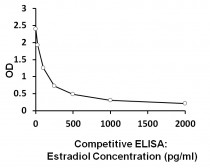ARG80839
Human Estradiol ELISA Kit
Human Estradiol ELISA Kit for ELISA and Human
Neuroscience kit
Overview
| Product Description | ARG80839 Human Estradiol ELISA Kit is an Enzyme Immunoassay kit for the quantification of Estradiol in serum and plasma (EDTA). |
|---|---|
| Tested Reactivity | Hu |
| Tested Application | ELISA |
| Target Name | Estradiol |
| Conjugation | HRP |
| Sensitivity | 10.6 pg/ml |
| Sample Type | Serum and plasma (EDTA, Citrate, heparin). |
| Standard Range | 25 - 2,000 pg/ml |
| Sample Volume | 25 µl |
Application Instructions
| Assay Time | 1.5 h, 30 min |
|---|
Properties
| Form | 96 well |
|---|---|
| Storage Instruction | Store the kit at 2-8°C. Keep microplate wells sealed in a dry bag with desiccants. Do not expose test reagents to heat, sun or strong light during storage and usage. Please refer to the product user manual for detail temperatures of the components. |
| Note | for laboratory research only, not for drug, diagnostic or other use. |
Bioinformation
| Background | Estradiol (1,3,5(10)-estratriene-3,17β-diol; 17β-estradiol; E2) is a C18 steroid hormone with a phenolic A ring. This steroid hormone has a molecular weight of 272.4. It is the most potent natural Estrogen, produced mainly by the Graffian follicle of the female ovary and the placenta, and in smaller amounts by the adrenals, and the male testes. Estradiol (E2) is secreted into the blood stream where 98% of it circulates bound to sex hormone binding globulin (SHBG) and to a lesser extent to other serum proteins such as albumin. Only a small fraction circulates as free hormone or in the conjugated form. Estrogenic activity is affected via estradiol-receptor complexes which trigger the appropriate response at the nuclear level in the target sites. These sites include the follicles, uterus, breast, vagine, urethra, hypothalamus, pituitary and to a lesser extent the liver and skin. |
|---|---|
| Function | In non-pregnant women with normal menstrual cycles, estradiol secretion follows a cyclic, biphasic pattern with the highest concentration found immediately prior to ovulation. The rising estradiol concentration is understood to exert a positive feedback influence at the level of the pituitary where it influences the secretion of the gonadotropins, follicle stimulating hormone (FSH), and luteinising hormone (LH), which are essential for folicular maturation and ovulation, respectively. Following ovulation, estradiol levels fall rapidly until the luteal cells become active resulting in a secondary gentle rise and plateau of estradiol in the luteal phase. During pregnancy, maternal serum Estradiol levels increase considerably, to well above the pre-ovulatory peak levels and high levels are sustained throughout pregnancy. Serum Estradiol measurements are a valuable index in evaluating a variety of menstrual dysfunctions such as precocious or delayed puberty in girls and primary and secondary amenorrhea and menopause. Estradiol levels have been reported to be increased in patients with feminising syndromes, gynaecomastia and testicular tumors. In cases of infertility, serum Estradiol measurements are useful for monitoring induction of ovulation following treatment with, for example, clomiphene citrate, LH-releasing hormone (LH-RH), or exogenous gonadotropins. During ovarian hyperstimulation for in vitro fertilisation (IVF), serum estradiol concentrations are usually monitored daily for optimal timing of human chorionic gonadotropin (hCG) administration and oocyte collection. |
| Highlight | Related products: Estradiol antibodies; Estradiol ELISA Kits; New ELISA data calculation tool: Simplify the ELISA analysis by GainData |
| Research Area | Neuroscience kit |
Images (1) Click the Picture to Zoom In
| Title | Download Link |
|---|---|
| ARG80839 Human Estradiol ELISA Kit User's manual |
 Download Download
|






